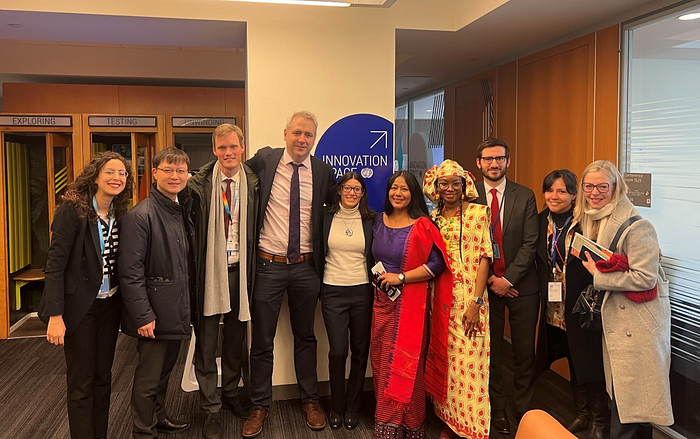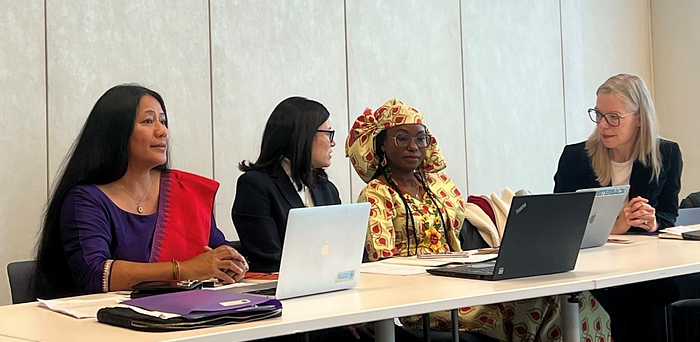Indigenous Peoples are among those most affected by climate-related risks. But they remain under-represented in the forums and processes where these issues are addressed, despite their knowledge and expertise.
Last December, the UN General Assembly called for Indigenous Peoples’ participation in peace negotiations, transitional justice, mediation, and conflict resolution. The decision aims to redress the historical exclusion of Indigenous Peoples from peace efforts affecting them. In the wake of the Assembly vote, on 7 February 2025, DPPA’s Policy and Mediation Division (PMD), as a member of the Climate Security Mechanism (CSM), together with the DPPA-DPO Americas Division invited two Indigenous women leaders — Hindou Oumarou Ibrahim, and Binalakshmi Nepram, UN Member States and practitioners for a UN Community of Practice on Climate, Peace & Security (CPS) meeting to discuss Indigenous Peoples’ peacebuilding in climate and conflict hotspots.
From concern to inclusion: Indigenous Peoples as partners in peace
At the meeting, participants discussed how building a better planet entails shifting mindsets about Indigenous Peoples and decision-making processes. “Please don’t worry about us, just include us” said Binalakshmi Nepram, Fellow at the Asia Centre, Havard University and Founder-President, Global Alliance of Indigenous Peoples, Gender Justice and Peace.
According to a report authored by UNEP-WCMC and ICCA Consortium, Indigenous Peoples manage around 25% of the world’s land and safeguard 80% of the world’s biodiversity, yet they experience higher rates of landlessness and forced displacement than other groups. Violence against and criminalization of environmental defenders represent additional challenges faced by Indigenous Peoples and peacebuilders in a climate changing world. Throughout the meeting, participants sought to better understand these challenges while also reflecting on examples of climate-informed peacebuilding efforts driven by actors from Indigenous Peoples, such as 3D participatory mapping exercises in Chad that aided mediation between farmers and pastoralists and also improved environmental sustainability. Indigenous Peoples mapped and documented their ancestral nomadic corridors, food, and medicines, bringing conflicting communities together around shared resources.

The environmental knowledge of Indigenous Peoples does not only contribute to climate adaptation, but also to conflict resolution and peacebuilding efforts. Participants at the meeting explored two implications of a recent study that found that 80% of armed conflicts between 1950 and 2000 occurred in biodiversity hotspots covering 2.4% of the Earth’s land mass. Most of these conflicts were on Indigenous Peoples’ land, yet the anthropogenic and environmental impacts of conflict were lower on Indigenous Peoples’ land than non-Indigenous land.
Participants observed that correlative evidence suggested that Indigenous Peoples were better positioned to steward and sustainably manage their land, even during conflict, demonstrating the need to integrate Indigenous Peoples peace and reconciliation practices into climate-informed peacebuilding. Second, conflicts stemming from resource exploitation — such as critical mineral mining — in biodiversity hotspots can be better prevented by including Indigenous Peoples in decision making about just transition and by codifying Indigenous Peoples rights in legislation. As tensions over critical minerals continue to rise, the absence of meaningful engagement between Indigenous Peoples and the private sector was also recognized as a critical gap to be addressed. Other suggestions stemming from the discussion included recognizing past harms to begin healing processes and engaging in good faith dialogues between government representatives and Indigenous Peoples.

Looking Ahead: Climate Change, Indigenous Peoples’ Peacebuilding, and the UN System
Within the multilateral system, international climate funds could create channels for Indigenous Peoples to directly access financing, strengthening their ability to manage their ecosystems on their own terms. The conversation then explored potential avenues to improve Indigenous People’s participation within the UN’s peacebuilding architecture and for Member States and UN entities to jointly advance the implementation of the previously mentioned resolution A/RES/79/159 on Indigenous Peoples in peacebuilding, including the possibility of dedicated a UN Peacebuilding Commission meeting on Indigenous Peoples peacebuilding in 2025.
Throughout the discussion, participants emphasized the need to ensure that Indigenous Peoples peacebuilders are meaningfully integrated into Climate, Peace and Security frameworks, decision-making, and peace processes. Doing so fosters more just, inclusive, contextually relevant, and sustainable solutions to the complex peace and security challenges linked to climate change. Alexandra Fong, Chief for Policy and Guidance at DPPA’s Policy and Mediation Division, stressed that, “Indigenous Peoples have a vital role, and DPPA and the CSM are committed to ensuring their inclusion in our climate, peace and security work.”

